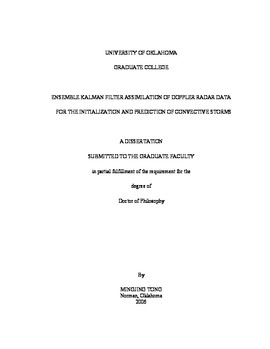| dc.contributor.advisor | Xue, Ming, | en_US |
| dc.contributor.author | Tong, Mingjing. | en_US |
| dc.date.accessioned | 2013-08-16T12:20:04Z | |
| dc.date.available | 2013-08-16T12:20:04Z | |
| dc.date.issued | 2006 | en_US |
| dc.identifier.uri | https://hdl.handle.net/11244/1001 | |
| dc.description.abstract | Finally, the EnSRF is applied to the May 29-30, 2004 central Oklahoma tornadic thunderstorm case. The initial storm environment is either horizontally homogeneous as defined by a single sounding or is three dimensional as obtained from a 3DVAR analysis of all available conventional observations. A full suite of model physics is employed in the latter case. Radial velocity and reflectivity from either one or two WSR-88D radars are assimilated. The results of the EnSRF analysis and the subsequent forecast are presented and a number of issues are discussed. | en_US |
| dc.description.abstract | For convective-scale prediction, microphyiscs parameterization is a major source of model error. Parameter estimation via state augmentation using an variant of EnKF, the ensemble square root filter (EnSRF), is applied to the correction of errors in fundamental parameters common in single-moment ice microphysics schemes, after parameter sensitivity and identifiability are examined. OSSEs are performed in which individual parameters are estimated separately or in different combinations. The estimation of individual parameters is successful while the level of difficulty increases as more parameters are estimated simultaneously. Explanations will be given as to why under certain circumstances the filter fails to estimate the correct values of parameters. Still, the state estimation is generally improved even when estimated parameters are inaccurate. | en_US |
| dc.description.abstract | As a first implementation, the simulated observations of radial velocity and reflectivity for a supercell thunderstorm are directly assimilated. The EnKF method is found to be able to retrieve accurately multiple microphysical species associated with a multi-class ice microphysics scheme. The relative role of radial velocity and reflectivity data as well as their spatial coverage in recovering the full flow and cloud fields are compared. The cross-covariance is shown to play an important role in retrieving variables indirectly related to the observations. | en_US |
| dc.description.abstract | Assimilation of Doppler radar data is very important for storm-scale NWP. To retrieve dynamically consistent wind, thermodynamic and microphysical fields from radar radial velocity and reflectivity, advanced data assimilation methods are required. This work explores the ability of the ensemble Kalman filter (EnKF) methods in assimilating Doppler radar data for thunderstorm initialization and prediction, as well as parameter estimation. | en_US |
| dc.format.extent | xx, 243 leaves : | en_US |
| dc.subject | Storms. | en_US |
| dc.subject | Physics, Atmospheric Science. | en_US |
| dc.subject | Weather forecasting. | en_US |
| dc.subject | Kalman filtering. | en_US |
| dc.subject | Geotechnology. | en_US |
| dc.title | Ensemble Kalman filter assimilation of Doppler radar data for the initialization and prediction of convective storms. | en_US |
| dc.type | Thesis | en_US |
| dc.thesis.degree | Ph.D. | en_US |
| dc.thesis.degreeDiscipline | School of Meteorology | en_US |
| dc.note | Adviser: Ming Xue. | en_US |
| dc.note | Source: Dissertation Abstracts International, Volume: 67-02, Section: B, page: 0942. | en_US |
| ou.identifier | (UMI)AAI3207565 | en_US |
| ou.group | College of Atmospheric & Geographic Sciences::School of Meteorology | |
